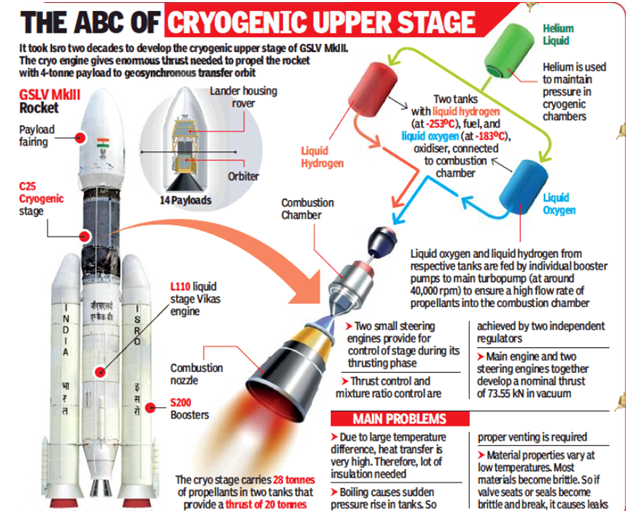GSLV-F10
For Prelims: Geosynchronous Satellite GSLV-F10/EOS-03 mission , Geosynchronous Satellite Launch Vehicle (GSLV), Types of launch vehicles.
For Mains: Space Technology, Types of launch vehicles and Related Issues.
Why in News?
In 2021, a high-level panel was established to examine the failed Geosynchronous Satellite GSLV-F10/Earth Observation Satellites (EOS)-03 mission and recommended measures for making the Cryogenic Upper Stage (CUS) more robust.
- The Geosynchronous Satellite Launch Vehicle (GSLV) with improvements added to its CUS is expected to be ready in the second half of this year.
What is a Geosynchronous Satellite Launch Vehicle (GSLV)?
- GSLV is a space launch vehicle designed, developed, and operated by the Indian Space Research Organisation (ISRO) to launch satellites and other space objects into Geosynchronous Transfer Orbits.
- GSLV has been designed for launching communication satellites.
- Geosynchronous satellites are launched into orbit in the same direction the Earth is spinning and can have any inclination.
- The satellites in the geosynchronous orbits appear to remain permanently fixed in the same position in the sky.
- GSLV has the capability to put a heavier payload in orbit than the Polar Satellite Launch Vehicle (PSLV).
- It is a three-stage launcher with strap-on motors.
What is Cryogenic Upper Stage?
- GSLV follows a solid fuel first stage with another liquid fuel stage coming next. The second stage is followed by a third stage known as CUS.
- It was the rocket’s crucial third stage, which then failed to ignite and led to the failure of the GSLV-F10.
- The cryogenic stage is technically a very complex system compared to solid or earth-storable liquid propellant stages due to its use of propellants at extremely low temperatures and the associated thermal and structural problems.
What are Earth Observation Satellites?
- Earth observation satellites are the satellites equipped with remote sensing technology.
- Earth observation is the gathering of information about Earth's physical, chemical and biological systems.
- Many earth observation satellites have been employed on sun-synchronous orbit.
- Other earth observation satellites launched by ISRO include RESOURCESAT- 2, 2A, CARTOSAT-1, 2, 2A, 2B, RISAT-1 and 2, OCEANSAT-2, Megha-Tropiques, SARAL and SCATSAT-1, INSAT-3DR, 3D, etc.
| Launch vehicles used by ISRO | |
|
Satellite Launch Vehicle (SLV): |
|
|
Augmented Satellite Launch Vehicle (ASLV): |
|
|
Polar Satellite Launch Vehicle (PSLV): |
|
| Small Satellite Launch Vehicle (SSLV): |
|
|
Geosynchronous Satellite Launch Vehicle (GSLV): |
|
|
Reusable Rockets/ Future Rockets: |
|
UPSC Civil Services Examination, Previous Year Questions (PYQs)
Q. With reference to India’s satellite launch vehicles, consider the following statements: (2018)
- PSLVs launch the satellites useful for Earth resources monitoring whereas GSLVs are designed mainly to launch communication satellites.
- Satellites launched by PSLV appear to remain permanently fixed in the same position in the sky, as viewed from a particular location on Earth.
- GSLV Mk III is a four-staged launch vehicle with the first and third stages using solid rocket motors, and the second and fourth stages using liquid rocket engines.
Which of the statements given above is/are correct?
(a) 1 only
(b) 2 and 3
(c) 1 and 2
(d) 3 only
Ans: (a)
